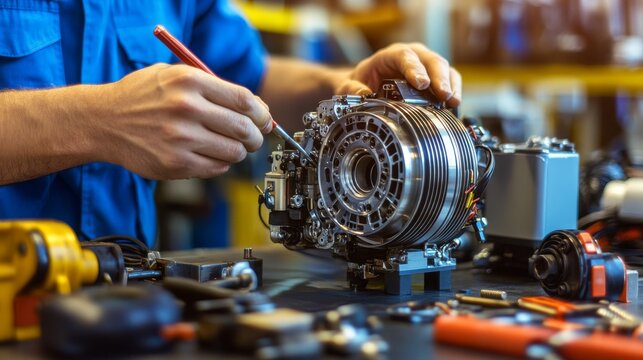10 Proven Ways to Extend Your Motor-Driven Systems’ Lifespan

When industrial motors drive a significant portion of your operations, it’s critical to ensure they run smoothly for as long as possible.
Extending the lifespan of motor-driven systems isn’t just about preventing costly downtime; it also optimises efficiency, reduces energy consumption, and minimises environmental impact.
This guide is tailored specifically for Maintenance Managers, Operations Supervisors, and Industrial Engineers who want a deeper understanding of how to maximise motor lifespan.
You’ll learn proven strategies for maintenance, predictive technologies, and how to make informed engineering choices that set your motors up for success.
Why Focus on Extending Motor Lifespan?
Industrial motors account for nearly 70% of electricity usage in industrial sectors and are critical to applications such as pumps, fans, and conveyors.
Premature failure of these systems isn’t just an inconvenience; it can result in production delays, costly repairs, and inefficiencies.
By implementing effective strategies, you can ensure consistent performance, optimise operational costs, and uphold environmental sustainability.
10 Key Strategies to Increase Motor Longevity
1. Prioritise Proper Installation
The foundation for a motor’s longevity is laid at the installation stage. Misaligned shafts, unbalanced loads, and improper mounting can lead to vibration and excessive wear. Ensure the following for proper installation:
- Conduct precision shaft alignment.
- Balance loads to avoid strain.
- Use vibration isolation mounts where necessary to protect equipment.
Correct installation can prevent long-term damage that’s difficult and expensive to reverse.
2. Choose the Right Motor for the Job
Selecting a motor that matches your operational requirements is critical. Factors such as torque demands, operating conditions (e.g., temperature, humidity), and mechanical loads must be considered. For example:
- Motors with IP (Ingress Protection) ratings are ideal for harsh or dusty environments.
- Consider energy-efficient motors with variable speed drives (VSDs) for applications with fluctuating load demands.
Tailoring your choice to your application ensures optimal performance and reduces unnecessary strain on the motor.
3. Implement Predictive Maintenance
Reactive maintenance is expensive and less effective over time. Predictive maintenance revolutionises motor care by using advanced tools like anomaly detection and condition monitoring. Key technological advancements include:
- Sensors for monitoring vibration, temperature, and current.
- Predictive analytics that leverage real-time machine learning models to anticipate failures.
Tools such as RealityCheck Motor or ABB Smart Sensors help identify potential issues long before they disrupt operations.
4. Regularly Lubricate Bearings
Motor bearings are essential for reducing friction and supporting loads, but they are often prone to wear. Regular lubrication is required to prevent overheating and early failure:
- Use manufacturer-recommended lubricants.
- Avoid over-lubrication, which can increase heat and damage seals.
Include lubrication schedules in your routine maintenance plan.
5. Perform Insulation Resistance Testing
Electrical faults are a common reason motors fail prematurely. Insulation resistance testing can detect deterioration in motor windings before it turns into a breakdown. Use tools like a megohmmeter to:
- Test electrical insulation yearly or biannually.
- Identify deteriorating windings that could lead to short circuits.
6. Ensure Cooling Systems are Functional
Excessive heat severely reduces the lifespan of motors. Motors rely on efficient cooling mechanisms, including fans and heat exchangers, to dissipate building heat. To maintain cooling efficiency:
- Regularly clean cooling vents and fins.
- Inspect fans for damage or debris blockages.
- For high-temperature environments, opt for motors with forced air cooling or thermal protection sensors.
7. Monitor and Avoid Voltage Fluctuations
Voltage irregularities can lead to motor overheating or even burnout:
- Install voltage stabilisers or surge protection devices to safeguard against spikes.
- Use frequency inverters to stabilise startup and operation phases, particularly in large systems.
8. Keep the Workspace Clean
Dust and contaminants can significantly impact motor performance by blocking air vents, contaminating lubricants, and damaging internal components. Maintain a clean environment by:
- Installing dust mitigation systems.
- Regularly cleaning motor components.
- Inspecting and replacing any compromised seals.
9. Address Vibration and Noise
Unusual vibrations and noise often signal misalignment or imbalance, which can escalate into more serious mechanical damage. Use vibration analysis tools to:
- Identify alignment issues early.
- Balance the rotor to eliminate excessive strain.
10. Upgrade When Necessary
Despite best efforts, motors eventually approach the limit of their performance capabilities. Incorporating system upgrades, such as retrofitting older motors with smart sensors or transitioning to higher efficiency models, can yield substantial longevity benefits.
Going Beyond Maintenance with a Comprehensive Approach
Extending the lifespan of your industrial motors requires more than scheduled maintenance. A holistic strategy that integrates predictive technologies, engineering foresight, and operational vigilance is key.
Organisations leading the way in motor longevity adopt the following practices:
- Utilising condition monitoring linked to centralised data systems for actionable insights.
- Employing eco-friendly motors that reduce energy consumption while delivering consistent torque.
- Prioritising collaboration between design engineers and maintenance teams during procurement to make informed motor selections.
Strengthening Operational Resilience Through Motor Care
Optimising the lifespan of motor-driven systems is an investment that pays dividends in downtime prevention, operational efficiency, and cost savings.
By adopting these proven methods, you’ll not only extend the working life of your motors but also ensure smoother operations across industrial applications.
For technical insights and seamless solutions, consider integrating predictive maintenance tools like RealityCheck Motor or ABB Ability sensors into your workflow. These technologies promise to elevate your maintenance strategy and future-proof your operations.